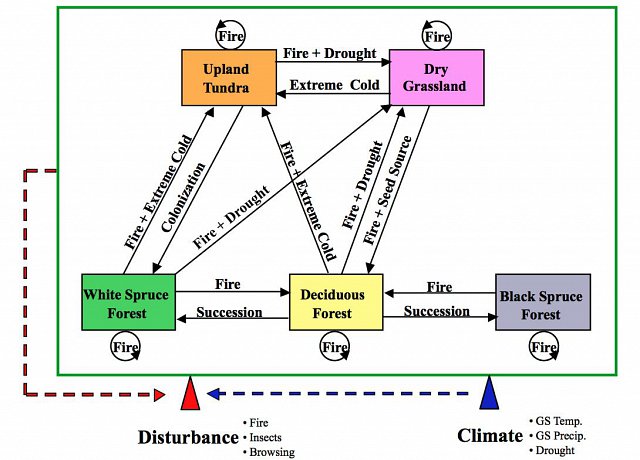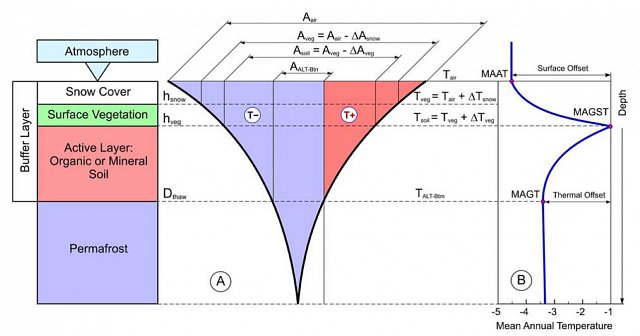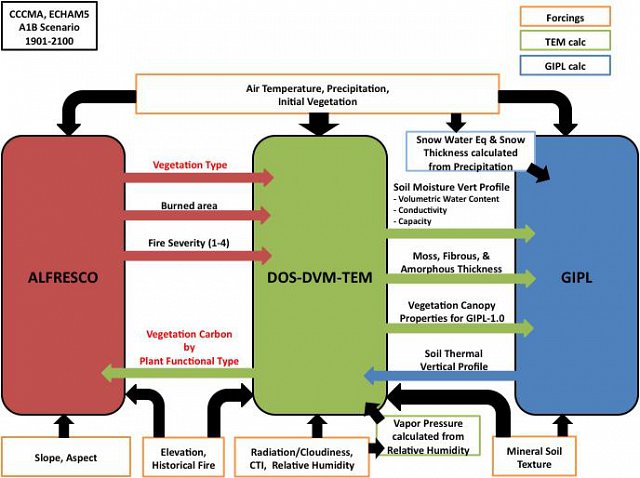Ecosystem Dynamics
Section III. Linking landscape heterogeneity with regional and global climate feedbacks
Interactions among changes in climate, ecosystem structure and function, and disturbance regimes affect exchanges of trace gases, water, and energy between the boreal forest and the atmosphere, and result in feedbacks to regional and global climate. Important positive feedbacks to climate warming include decreases in surface albedo due to changes in snow cover, and respiratory release of permafrost C. Negative feedbacks include increases in surface albedo due to a greater proportion of the landscape occupied by deciduous forest accompanying a shorter fire-return interval, and greater vegetation C uptake resulting from an extended growing season. Our study of the net effects of these feedbacks uses retrospective and prospective modeling to integrate field-based assessments of disturbance and climate-change effects on net ecosystem C balance with a regional assessment of the mechanisms and patterns of change in landscape structure and function. A suite of models including the Terrestrial Ecosystem Model (TEM), ALFRESCO, and the Geophysical Institute Permafrost Lab's (GIPL) model, is being developed and continuously refined by the BNZ LTER to address how changing climate-disturbance interactions are influencing regional ecosystem dynamics and climate feedbacks.

Conceptual diagram of the Terrestrial Ecosystem Model (a), which includes modules of dynamic organic soil layers (b) and dynamic vegetation (c). In the dynamic vegetation module, each ecosystem (e.g., black spruce forest, white spruce forest, deciduous forest) may include up to nine plant functional types (including black spruce trees, white spruce trees, deciduous trees, deciduous shrubs, evergreen shrubs, grasses, sedges, mosses, lichens, forbs). C and N fluxes (e.g., net primary productivity, autotrophic respiration, nitrogen uptake, nitrogen resorption) are calculated for the individual plant functional types. The plant functional types within an ecosystem compete among one another for light, soil N availability, and water. The soils of the dynamic vegetation module are linked to the module of dynamic organic soil layers, which includes three layers: snow, soil, and bedrock. The soil layer consists for four sub-layers representing moss, shallow organic matter, deep organic matter, and mineral soil. Snow layers are subjected to accumulation and melt. Moisture is only updated for unfrozen portions of the soil layer. Temperature is updated for all layers of the ground structure. Moss and portions of the organic matter sub-layers can be removed by wildfire and can re-grow after fire disturbance. All sub-layers of the soil layer are considered in calculating C balance.

ALFRESCO is a spatially-explicit, probabilistic model that distributes habitat types and large herbivores across the landscape in response to climate and disturbance regimes. The model operates on an annual time step, in a landscape composed of 1 × 1 km pixels, a scale appropriate for interfacing with mesoscale climate and carbon models. The model simulates five major subarctic/boreal ecosystem types: upland tundra, black spruce forest, white spruce forest, deciduous forest, and grassland-steppe. These ecosystem types represent a generalized classification of the complex vegetation mosaic characteristic of the circumpolar arctic and boreal zones of Alaska. BNZ LTER runs ALFRESCO in close association with Scenarios Network for Arctic and Alaska Planning (SNAP).

The Geophysical Institute Permafrost Lab (GIPL) model was developed specifically to assess the effect of a changing climate on permafrost. GIPL 1.0 is a quasi-transitional, spatially distributed, equilibrium model for calculating the active layer thickness and mean annual ground temperature. Input parameters are spatial datasets of mean monthly air temperature and precipitation, prescribed vegetation, soil thermal properties, and water content, which are specific for each vegetation and soil class and geographical location. This figure shows the GIPL-1 model conceptual diagram (A) and schematic profile of mean annual temperature through the lower atmosphere, active layer and upper permafrost (B).

The BNZ LTER has developed a framework that allows for the synchronous coupling among ALFRESCO, TEM and GIPL-1 in the Integrated Ecosystem Model for Alaska and Northwest Canada. This example couples (1) a model of disturbance dynamics and species establishment (ALFRESCO), (2) a model of soil dynamics, hydrology, vegetation succession, and ecosystem biogeochemistry (TEM), and (3) a model of permafrost dynamics (GIPL) to address how changes in climate and fire regime will influence interactions between vegetation structure, ecosystem function and permafrost distribution.
 B
B

